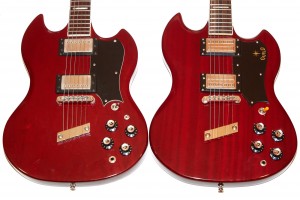
The Guild S-100 is one of their most popular Guild electric guitars, so I thought I would take the time to put two of the most common models available today side by side. Let’s see how they compare.
Introduction
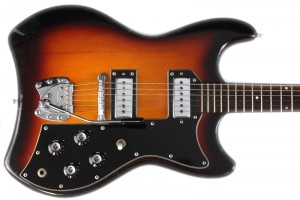
1970s
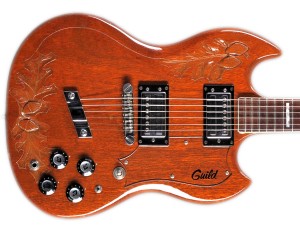
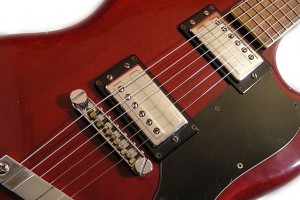
1990s
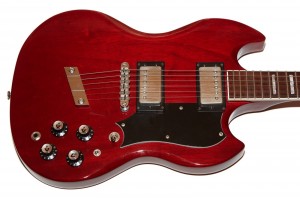
Additionally, the necks on these 1990s models are wider, measuring 1 11/16″ at the nut according to the published specs which is wider than the 1970s S-100s, a detail that makes them a winner in my book. For me, both necks feel great, but only if the 1970s neck is deeper. Since they were all hand carved back then, it can be a matter of chance whether you get a pencil-thin neck which is what I seem to get every time I find a 1970s model. I generally gravitate to the wider fretboards which is why I’ve never owned a 1970s era S-100.
Both the 1970s S-100s and the 1990s reissue S-100s were made in Guild’s Westerly plant in Rhode Island.
2010s
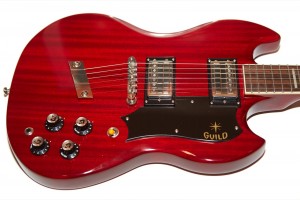
These Newark Street S-100s first came equipped with mini-humbuckers, but were quickly replaced the next year with full-sized recreations of the venerable Guild HB1. They do not have a phase switch, and sport wood with more character than either of the other series generally shows, though it is unclear if this is a veneer. The switch tip is plastic on this series, and the pick guard shows the old Guild logo. Though these guitars are import copies, they do have a quality feel to them, and should not be dismissed.
Since I don’t have a 1970s S-100, I’ll compare a 1997 Guild S-100 to a 2015 Newark Street S-100.
Finish
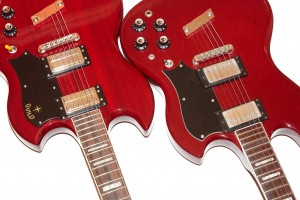
The poly finish on the NS S-100 is thin enough so that it feels nice, but it does not (and will never) have the wonderful feel of aged lacquer. Does that matter? Only you can decide.
Both guitars are finished beautifully. Note that the Newark Street model has what appears to be a more transparent finish.
Fretboard and Neck
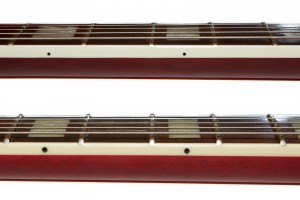
The Newark Street S-100 has much more modern frets with much more meat on them. The neck on the NS model is thinner, though, but with the meatier frets it seems to balance out. Since both have the same strings (Ernie Ball 10s), I measured with calipers over the strings at the first fret since I was too lazy to remove the strings again. The NS guitar measured 22.22mm while the ’97 measured 23.48mm. And yes, the fret markers on the binding are larger on the Newark Street S-100.
The frets themselves measure as follows. Remember that I’m measuring used guitars, so wear and grime will affect the measurements.
| Guitar | Width | Height |
|---|---|---|
| 1997 S-100 | 2.14 mm | 1.04 mm |
| 0.084 in | 0.040 in | |
| 2015 S-100 | 2.30 mm | 1.44 mm |
| 0.090 in | 0.055 in |
Both guitars are advertised as having 1 11/16″ necks but from what I can tell, neither of them do. A 1 5/8″ neck (the size commonly used by Guild in the 1970s) is 41.275mm while 1 11/16 inch is 42.8625mm. The 1997 S-100 measures 43.8mm at the nut (a full mm over 1 11/16″), while the 2015 NS S-100 measured at 42.22mm at the nut (1/2mm under 1 11/16″). I measured each probably 10 times because I couldn’t believe what I was seeing. Neither of them measured at 1 11/16″, but the 1997 model is definitely wider.
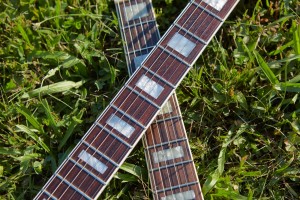
Guild lists the inlays on the Newark Street S-100 as “pearloid block”. Pearloid is a fancy name for plastic, though there have been some version of Perloid inlays on guitars from every brand for decades. From what I’ve been able to find out, the inlays on the 1997 S-100 are not Mother of Pearl (MOP) as originally listed, but something called PolyPearl, which is a polyester substance with the appearance of MOP. Whatever the difference, the inlays on the 1997 are much prettier and much more iridescent than the ones on the NS model.
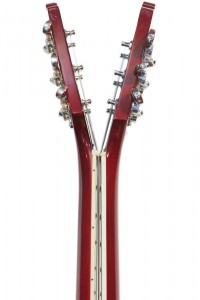
The neck angle on these guitars can be problematic because if you lay the guitar down on the ground (which you shouldn’t do), then the top of the headstock contacts the floor before the base of the neck does. In other words, if your precious S-100 falls from the guitar stand on stage, there’s a good chance that your guitar will suffer a neck break. The break angle is not as severe as it is on some Gibsons, but it can still be a problem because of the thin body on the S-100. Bottom line: don’t let your Guild fall off of the stand.
Build Quality
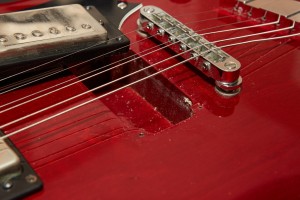
The difference in weight between the two is 12oz, which is 3/4 of a pound with the older guitar being the lighter of the two. The 1997 S-100 weighs in at 7 lbs 12 oz while the Newark Street S-100 weighs 8 lbs 8oz.
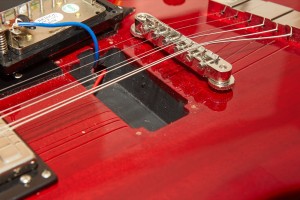
Pickups
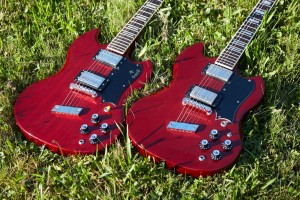
The 1997 model includes a phase switch, while the Newark Street S-100 does not. Both guitars sound great, but I would give the edge to the 1997 model since it seems to have more clarity and articulation than the Newark Street model, though that could be a result of better electrical components in the 1997.
The Newark Street model has more high-end and sounds chimier, likely due to the difference in the specs between the pickups in use. See the Sound section for more detail. Remember, pickups are easy to swap, and doing so can have a dramatic effect on a guitar’s tone.
Electronics
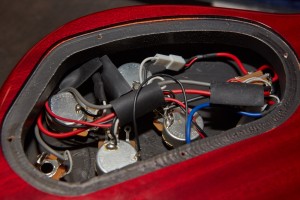
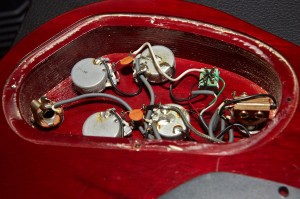
I know most people will never see the wiring, but the electrical engineer that lives in my brain (thanks dad!) is much happier when looking at the 1997 wiring cavity. Attention to detail is a big deal for me, and the older guitar wins there, even if it is hidden most of the time.
Hardware
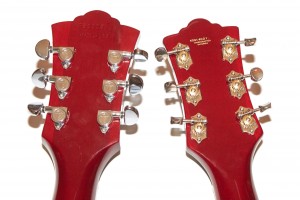
As a fun aside, I never noticed the difference in the headstock shape until I looked at the picture of the headstocks side by side. The 1997 S-100 has a much wider, more masculine looking headstock while the Newark Street S-100 has less material on the sides which makes it appear much thinner and more curved.
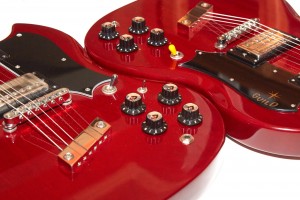
The phase switch reverses the polarity of one pickup so that when both pickups are selected you have the choice between “normal” and that sort of nasally Peter Greene sound or even a sort of single-coil (but not exactly) sound. As a life-long Guild owner, I feel that this phase switch is part of what gives old Guild electrics their appeal, so I was bummed to see it missing on the Newark Street model, though I assume that, like the ugly plastic switch tip, it was removed in the name of cost reduction. Technically the 1970 S-100 didn’t have a phase switch, so I guess it’s technically accurate even if it is lame.
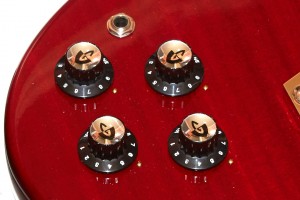
Sound
They can both sound pretty similar, though the nod for me goes to the 1997 for its more articulate tone and increased flexibility gained with the phase switch.
But there’s a catch.
The 2015 Newark Street (NS) S-100 has a much chimier tone than the 1997 S-100. When playing them both side by side into the same amp, I described the NS model as “spankier”, which my daughter thought was hysterical. There’s more high-end chime in the NS model, but there’s more grunt and articulation in the 1997 model. Remember, the bridge pickup in the 1997 model measures at something like 17k, while the reissue HB1 measures more like 7k, so there’s significantly more winding in the Seymour Duncan which is likely what’s causing that chime to be lost.
The 1997 definitely has a fatter, more grungy tone which would make it the perfect choice for anyone chasing that C# standard drop-tuning stoner rock sound, but the cool thing about this guitar is that it’s in no way limited to such a sound.
1997 S-100 Bridge Pickup
2015 S-100 Bridge Pickup
1997 S-100 All Pickups
2015 S-100 All Pickups
Playability
These guitars feel pretty similar since they share the same size and shape, but the Newark Street (NS) S-100 is noticeably heavier. The neck is chunkier on the 1997 and the radius is flatter, but the frets are higher on the 2015 NS guitar.
The frets are much lower on the 1997 model, and this is not due to wear, but rather what was fashionable at the time on Guild electrics.
Neither of these guitars is neck-heavy, which is something I dislike about many of the Gibson SGs I’ve played.
When tuned down a whole step or more, the strings can get all sorts of floppy on either guitar since the bridge is so far away from the tailpiece which makes the string angles quite obtuse. Since these are 23 3/4″ scale guitars, I tend to prefer 10s on them whereas I’ll put 9s on a longer scale guitar like a Strat.
High-fret access is excellent on both due to the double-cutaway coupled with the set neck design.
Conclusion
So, which one wins?
For my money, the winner is the 1997 S-100. I make this statement as someone who has almost four decades of experience with Guilds, and as someone who knows what they like the minute they pick it up. This guitar feels better and sounds better to me.
But it’s not that simple. Some people don’t like the super flat radius on the 1997’s fretboard, and many people don’t like the low flat frets. By the same token, some people don’t like the Guild logo on the NS guitar, or the open tuners. The best advice is to play one of each, but if that’s not possible, then rest assured both of these guitars are damn good instruments.
When I was a kid deep in the last millennium, import guitars mostly sucked. If you bought the import model of a famous guitar, you could almost guarantee that it wouldn’t stay in tune, the electronics would suck, and it wouldn’t play or sound anything like the original. That is not the case with the Newark Street Guilds, and though the NS has more chime, that’s because it has pickups that were included in the 1970s S-100s, which had more chime than the Seymour Duncans found in my 1997 reissue.
I’ve owned two Newark Street Guilds now; an X175-B, and this S-100, and I can say that these are great guitars. If I could have had one of these when I was 13 and just starting out, I would have been thrilled beyond belief.
The reason for the comparison is that I got both of these guitars for almost the same price, and if you come across the guitars for similar prices, I think you’ll get more for bang for your buck from the 1990s model. Honestly, though, it’s a great problem to have, since they’ll both play great and last you for years.
I still maintain that I’ve never played a bad Guild.
Donate: PayPal Crypto:
ETH: 0x0AC57f8e0A49dc06Ed4f7926d169342ec4FCd461
Doge: DFWpLqMr6QF67t4wRzvTtNd8UDwjGTQBGs


